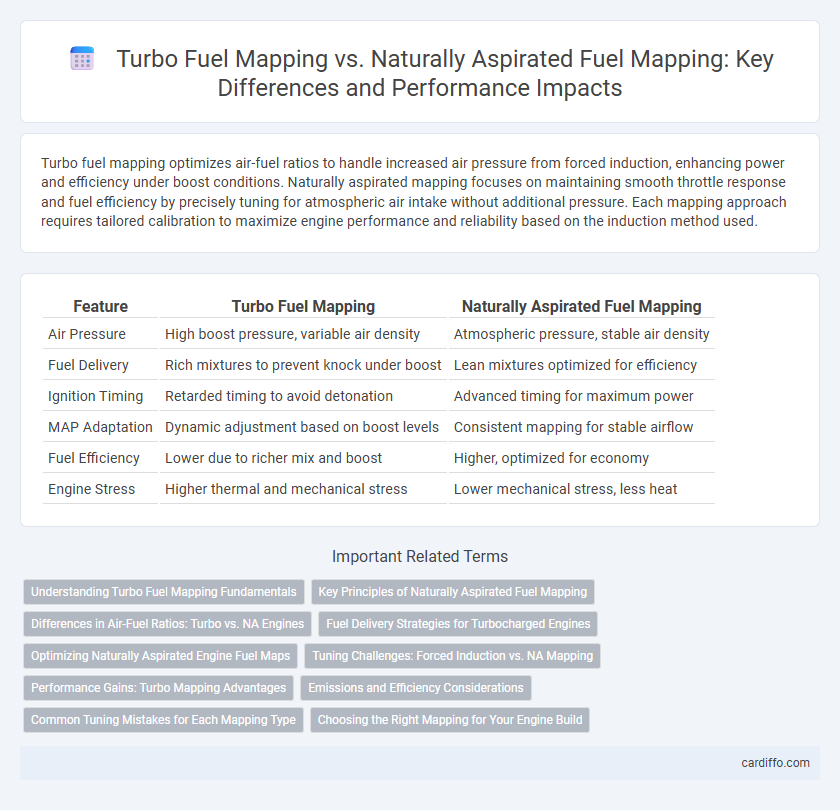Turbo fuel mapping optimizes air-fuel ratios to handle increased air pressure from forced induction, enhancing power and efficiency under boost conditions. Naturally aspirated mapping focuses on maintaining smooth throttle response and fuel efficiency by precisely tuning for atmospheric air intake without additional pressure. Each mapping approach requires tailored calibration to maximize engine performance and reliability based on the induction method used.
Table of Comparison
| Feature | Turbo Fuel Mapping | Naturally Aspirated Fuel Mapping |
|---|---|---|
| Air Pressure | High boost pressure, variable air density | Atmospheric pressure, stable air density |
| Fuel Delivery | Rich mixtures to prevent knock under boost | Lean mixtures optimized for efficiency |
| Ignition Timing | Retarded timing to avoid detonation | Advanced timing for maximum power |
| MAP Adaptation | Dynamic adjustment based on boost levels | Consistent mapping for stable airflow |
| Fuel Efficiency | Lower due to richer mix and boost | Higher, optimized for economy |
| Engine Stress | Higher thermal and mechanical stress | Lower mechanical stress, less heat |
Understanding Turbo Fuel Mapping Fundamentals
Turbo fuel mapping requires precise calibration of air-fuel ratios to accommodate forced induction, ensuring optimal combustion under increased pressure and temperature conditions. Unlike naturally aspirated engines, turbocharged engines demand richer mixtures during boost to prevent knocking and maintain engine durability. Effective turbo fuel mapping balances fuel delivery with boost levels, maximizing power output and efficiency while protecting internal components.
Key Principles of Naturally Aspirated Fuel Mapping
Naturally aspirated fuel mapping relies on precise air-fuel ratio control to ensure optimal combustion without forced induction pressure changes. Key principles include maintaining a stoichiometric balance throughout the RPM range and adjusting fuel delivery based on throttle position, engine load, and intake air temperature. This approach maximizes engine efficiency and responsiveness by focusing on smooth fueling transitions and avoiding lean or rich conditions that can compromise performance or emissions.
Differences in Air-Fuel Ratios: Turbo vs. NA Engines
Turbocharged engines operate with richer air-fuel ratios during boost conditions, typically ranging from 11.5:1 to 12.5:1, to prevent detonation and ensure optimal combustion under high pressure. Naturally aspirated (NA) engines maintain leaner air-fuel ratios around 14.7:1 at stoichiometric levels for efficient fuel economy and emissions control. The difference in air-fuel ratios reflects the varying demands of forced induction versus atmospheric intake, with turbo mapping prioritizing mixture richness for engine safety and power output.
Fuel Delivery Strategies for Turbocharged Engines
Turbo fuel mapping involves precise calibration of fuel delivery to manage the increased air pressure from forced induction, optimizing combustion efficiency and preventing detonation. Fuel delivery strategies for turbocharged engines rely on variable injection timing, increased fuel flow rates, and adaptive fueling based on boost levels to maintain the ideal air-fuel ratio under varying load conditions. Unlike naturally aspirated mapping, turbo maps prioritize managing transient fuel enrichment and cooling effects to accommodate higher cylinder pressures and temperatures, enhancing power output and engine reliability.
Optimizing Naturally Aspirated Engine Fuel Maps
Optimizing naturally aspirated engine fuel maps involves precise calibration of air-fuel ratios to maximize combustion efficiency and power output without forced induction. Unlike turbo fuel mapping, which must account for variable boost pressures and increased intake air density, naturally aspirated mappings focus on steady states and transient response optimization under atmospheric pressure. Advanced techniques use detailed volumetric efficiency modeling and real-time adaptive fuel control to enhance drivability and emissions performance in naturally aspirated engines.
Tuning Challenges: Forced Induction vs. NA Mapping
Turbo fuel mapping requires precise control over air-fuel ratios to manage boost pressure and prevent knock, demanding advanced tuning strategies compared to naturally aspirated (NA) engines. Forced induction introduces variables such as turbo lag, varying boost levels, and increased intake air temperature, complicating fuel delivery and ignition timing adjustments. NA mapping relies on relatively stable airflow and consistent engine load, making its tuning less complex but less adaptable to rapid changes in combustion conditions.
Performance Gains: Turbo Mapping Advantages
Turbo fuel mapping enhances engine performance by precisely adjusting air-fuel ratios under boost pressure, resulting in increased power output and improved throttle response. Optimized turbo maps reduce knock risk and support higher boost levels, enabling efficient combustion and maximizing horsepower gains. Compared to naturally aspirated mapping, turbo calibration delivers superior torque delivery across a broader RPM range, ensuring optimal engine efficiency and acceleration.
Emissions and Efficiency Considerations
Turbo fuel mapping optimizes air-fuel ratios to improve combustion efficiency and reduce emissions by precisely controlling boost pressure and fuel delivery, resulting in lower particulate and NOx outputs. Naturally aspirated mapping relies on a stable, lower intake air pressure, often requiring richer mixtures to maintain power, which can increase fuel consumption and emissions compared to turbocharged engines. Efficient turbo fuel mapping leverages advanced sensors and ECU calibration to balance power demands with stricter emission standards, enhancing overall fuel economy and environmental performance.
Common Tuning Mistakes for Each Mapping Type
Turbo fuel mapping often suffers from overly aggressive air-fuel ratios, causing turbo lag and engine knock due to improper boost control. In naturally aspirated mapping, common tuning errors include running excessively rich mixtures that reduce power and efficiency, or lean mixtures that risk engine damage during high load conditions. Both mapping types require precise fuel delivery adjustments to optimize combustion and prevent early engine wear.
Choosing the Right Mapping for Your Engine Build
Turbo fuel mapping optimizes air-fuel ratios for forced induction, providing precise fuel delivery under boost pressure to enhance power and prevent detonation. Naturally aspirated mapping focuses on smooth throttle response and fuel efficiency, balancing air-fuel mixtures without the complexity of boost variability. Selecting the right mapping depends on engine build goals, turbocharger size, and desired performance characteristics.
turbo fuel mapping vs naturally aspirated mapping Infographic

 cardiffo.com
cardiffo.com